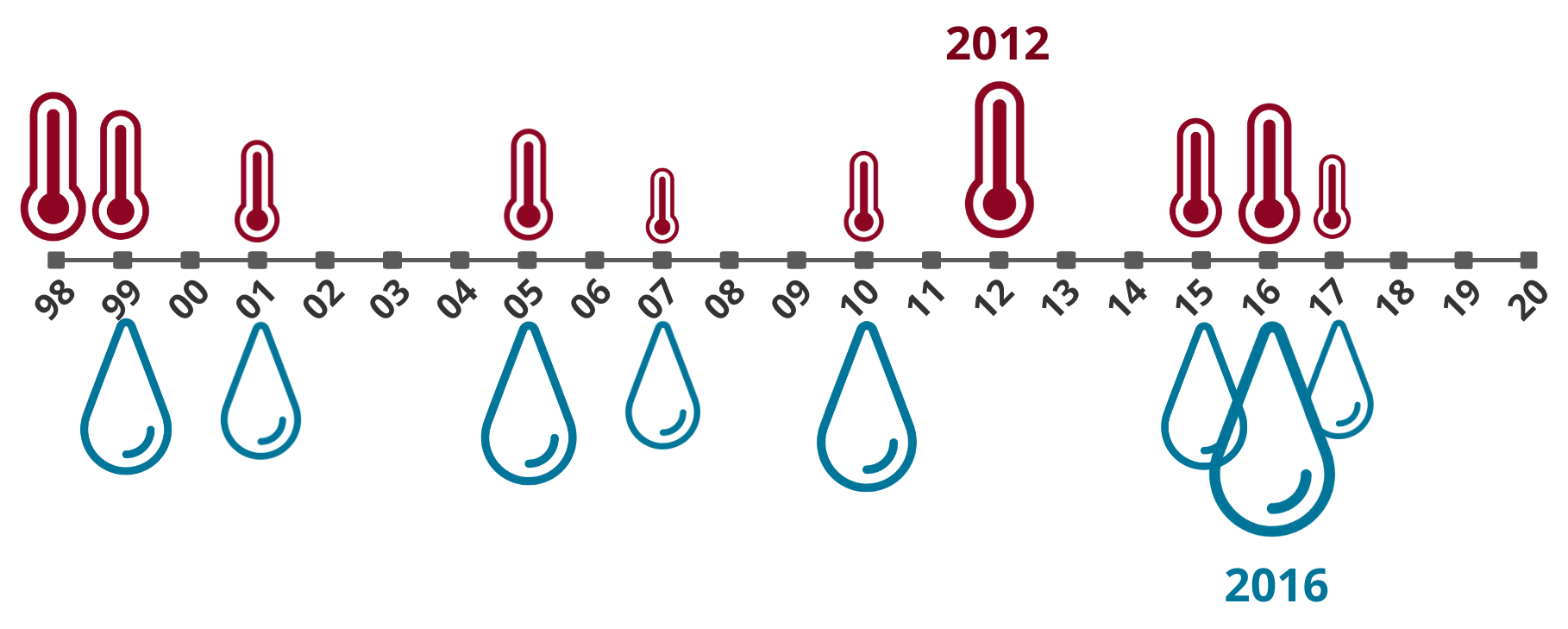Our Changing Temperature
Nine of Minnesota's warmest 16 years on record have occurred since 20005.
Minnesota is warming. Average annual temperature across the state has increased nearly 3℉ since the late 1800s6, with Minnesota outpacing the average rate of warming globally. The warming has also accelerated in recent years, with the warming rate between 1980 and 2010 greater than between 1950 and 20107.

Source: Minnesota Department of Natural Resources
Although Minnesota is famous for its frigid winters, winters don't get as cold as they used to: from 1944 to 1993, 44 out of 50 winters in Minnesota registered -40℉ at some point, but from 1995 to 2017, only 13 out of 22 winters reached the same temperature (MN DNR).


In the future, we can expect that winters will continue to warm and the number of days with snow cover will decrease3. We can also expect the growing season to continue to lengthen as the spring thaw moves earlier and the first freeze in autumn shifts later in the season7. Although there isn't yet discernible evidence that hot days are getting hotter, we can expect days warmer than 90 degrees or even 100 degrees Fahrenheit to become more common7.

(Source: MN DNR)
Consequences
References & Suggested Reading
1Harding, K. J., and P.K. Snyder, 2014: Examining future changes in the character of Central U.S. warm-season precipitation using dynamical downscaling, Journal of Geophysical Research: Atmospheres, 119, doi: https://doi.org/10.1002/2014JD022575.
2Harding, K. J., and P.K. Snyder, 2015: Using dynamical downscaling to examine mechanisms contributing to the intensification of Central U.S. heavy rainfall events, Journal of Geophysical Research: Atmospheres, 120, doi:10.1002/2014JD022819.
3Liess, S., Twine, T. E., Snyder, P. K., Hutchison, W. D., Konar-Steenberg, G., Keeler, B. L., & Brauman, K. A. (2022). High-resolution Climate Projections over Minnesota for the 21st Century. Earth and Space Science, 9, e2021EA001893. https://doi.org/10.1029/2021EA00189
4Melillo J., T. Richmond, and T. Yohe, 2014: An assessment from the U.S. Global Change Research Program to inform the public with scientific information and methods regarding climate change.
5Midwestern Regional Climate Center, 2021. https://mrcc.illinois.edu/. Accessed Aug 17, 2021
6Minnesota Department of Natural Resources, 2021: "Climate Change and Minnesota". https://www.dnr.state.mn.us/climate/climate_change_info/index.html.
7Pryor, S. C., D. Scavia, C. Downer, M. Gaden, L. Iverson, R. Nordstrom, J. Patz, and G. P. Robertson, 2014: Ch. 18: Midwest. Climate Change Impacts in the United States: The Third National Climate Assessment, J. M. Melillo, Terese (T.C.) Richmond, and G. W. Yohe, Eds., U.S. Global Change Research Program, 418-440. doi:10.7930/J0J1012N.
8USGCRP, 2018: Impacts, Risks, and Adaptation in the United States: Fourth National Climate Assessment, Volume II [Reidmiller, D.R., C.W. Avery, D.R. Easterling, K.E. Kunkel, K.L.M. Lewis, T.K. Maycock, and B.C. Stewart (eds.)]. U.S. Global Change Research Program, Washington, DC, USA, 1515 pp. doi: 10.7930/NCA4.2018.


